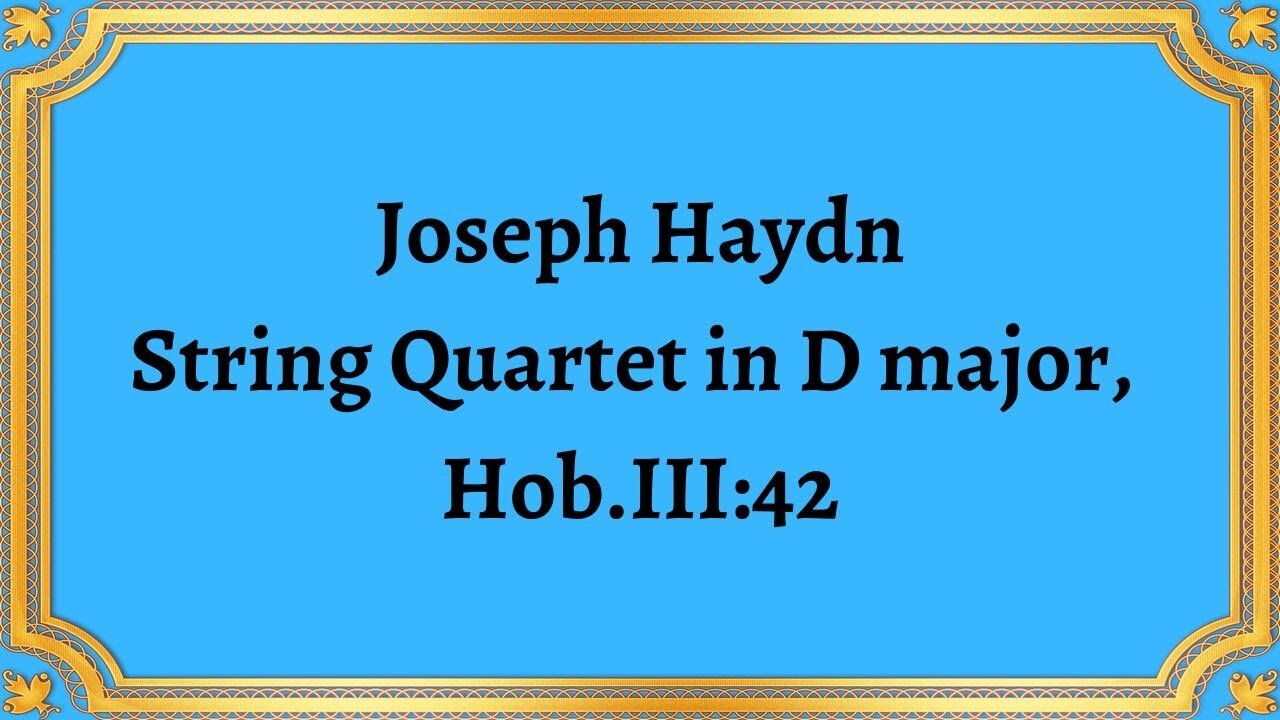Premium Only Content

Joseph Haydn String Quartet in D major, Hob.III:42
#JosephHaydn#StringQuartet#Dmajor#HobIII:42#ChamberMusic#ClassicalPeriod#musicalcomposition
Joseph Haydn was a prolific composer of chamber music, and one of his most famous works in this genre is the String Quartet in D major, Hob.III:42. The composition dates back to Haydn's later period and was written in 1781. It is one of six quartets from Opus 33, which all contain an extraordinary blend of innovation, mastery of form, and playful humor.
The String Quartet in D major, Hob.III:42 is comprised of four movements, each of which presents different musical ideas and technical challenges to performers. The opening movement, Allegro Moderato, features a brisk tempo and a cheerful mood. It showcases Haydn's expertise in creating a sense of the unexpected, with frequent shifts in tonality and dynamics.
The second movement, Menuetto, is a playful dance that features a unique trio section that is an example of Haydn's humorous tone. The trio uses a goofy pizzicato rhythm that adds to the whimsical nature of the piece.
The third movement is Adagio, a slow and reflective section that showcases the quartet's melodic capabilities. The cello takes the lead in this movement, with the other three instruments providing a lush and supportive harmonic backdrop.
Finally, the String Quartet in D major ends with a Presto that is full of energy and virtuosity. Here, Haydn pushes the musicians to their limits as they race through the intricate runs and rapid-fire passages.
One of the most striking features of Haydn's String Quartet in D major, Hob.III:42 is the creative use of harmony and counterpoint. Throughout the composition, he employs some of the most innovative techniques of the time, with frequent changes in texture, dynamics, and tonality. The result of this experimentation is a dynamic musical tapestry that is both inventive and captivating.
In conclusion, the String Quartet in D major, Hob.III:42 by Joseph Haydn is a masterpiece of chamber music that showcases the composer's skills in melody, harmony, and counterpoint. Its playful and light-hearted tone, combined with its technical challenges, make it a challenging piece for musicians while also allowing audiences to appreciate the composer's great skill in small-scale ensembles. As such, it remains one of the most popular chamber works of the Classical period.
You have the opportunity to support the channel https://destream.net/live/RadSiarAl/donate
-
 4:24
4:24
Classical music_Music Inspiration
1 month agoFrederic Chopin Fantasy-Impromptu in C-sharp minor, Op 66
831 -
 LIVE
LIVE
Dr Disrespect
7 hours ago🔴LIVE - DR DISRESPECT - ARC RAIDERS - QUEST MASTER
1,961 watching -
 2:17:37
2:17:37
The Quartering
3 hours agoFooled Again! Mamdani Backtracks Everything & Today's Breaking News!
158K64 -
 1:17:04
1:17:04
DeVory Darkins
4 hours agoPelosi SURRENDERS announces retirement and Bernie Sanders makes stunning admission
80K96 -
 LIVE
LIVE
StoneMountain64
4 hours agoArc Raiders is actually INCREDIBLE
128 watching -
 LIVE
LIVE
FusedAegisTV
6 hours agoFUSEDAEGIS PLAYS THE GREATEST JRPG EVER MADE ⌛► CHRONO TRIGGER (1995) Part 4
93 watching -
 1:57:50
1:57:50
The Charlie Kirk Show
5 hours agoErika's Interview + Auburn Aftermath | Schlichter, Lomez | 11.6.2025
86.8K18 -
 LIVE
LIVE
ZWOGs
5 hours ago🔴LIVE IN 1440p! - ARC RAIDERS w/ @SilverFox & @svgames! - Come Hang Out!
104 watching -
 LIVE
LIVE
The Rabble Wrangler
14 hours agoBattlefield with The Best in the West
45 watching -
 1:02:01
1:02:01
Sean Unpaved
5 hours agoTragedy Strikes: Kneeland's Remembrance, Spo's Inferno, CFB HC Rumors, & TNF Raiders-Broncos' Odds
56.5K